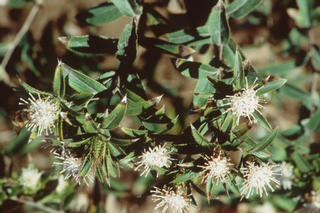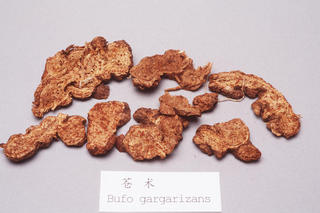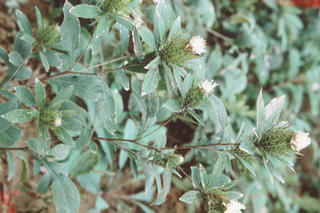Atractylodes chinensis
Contents
Nomenclature
Other Names:
Historical Use of Atractylodes chinensis
Atractylodes chinensis in Traditional Chinese Medicine
Background
Maocangzhu é²ÔÊõ
Zhicangzhu ÖƲÔÊõ
Chinese Name (pinyin): Cangzhu
Chinese Name :
Common Name :Atractylodes Rhizome
Specific Name : Rhizoma atracylodis
Scientific Name:
Collection : The drug is collected in spring and autumn, removed from soil, dried and dashed to discard the fibrous roots.
Description : Nodular slice or nodular cylindrical, 4 - 9 cm long, 1 - 4 cm in diameter. Externally blackish brown when peeled. Texture lax, fracture scattered with yellow oil cavities. Odour weakly aromatic, taste pungent and bitter.
Identification : 1.Powder: Brown, needle crystals minute, 5 - 30 µm long, irregularly filled in parenchymatous cells. Fibres mostly in bundles, long fusiform up to 40 µm in diameter with rather thickened lignified walls. Stone cells fairly abundant, sometimes linking up with cork cell, polygonal sub rounded or sub rectangular. 20 - 80 µm in diameter with heavily thickened walls. Inulin frequently visible with radial striations on surface.2.Macerate 1 g of the powder with 5 ml of ether for about 5 minutes and filter. Add several drops of the filtrate to a white porcelain plate. After evaporating the ether, add 1 - 2 drops of a mixture freshly prepared with 2 g of p-dimethylaminobenzaldehyde. 3.3 ml of sulfuric acid and 0.4 ml of water and add 2 drops of ethanol, a rose red colour is produced.3.To 0.5 g of the powder add 2 ml of n-hexane, ultrasonicate for 15 minutes, filter and use the filtrate as the test solution. Prepare a solution of Rhizoma Atractylodis reference drug in the same manner as the reference drug solution. Carry out the method for thin layer chromatography (Appendix Vl B), using silica gel G as the coating substance and petroleum ether (60 - 90ºC)-ethyl acetate (20:1) as the mobile phase. Apply separately to the plate 10 µl of each of the two solutions. After developing and removal of the plate, dry it in the air and spray with 5% solution of p-dimethylaminobenzaldehyde in ethanol containing 10% sulfuric acid, visualized with a current of hot air. The spots in the chromatogram obtained with the test solution correspond in position and colour to the spot in the chromatogram obtained with the reference drug solution and same dirty green principal spot (atractydin) is shown in both chromatogram.Total ash: Not more than 7.0% (Appendix LX K)
Processing : Rhizoma Atractylodis: Eliminate foreign matter, wash clean, soften thoroughly, cut into thick slices and dry.(stir fried with bran): stir fry the slices as described under the method for stir frying with bran (Appendix ll D) until its outer surface becomes deep yellow. Sub rounded or slated thick slice, scraps not more than 3%.
Action : To remove damp and invigorate the funtion of the spleen, to dispel wind-cold, and to improve eyesight.
Indication : epigastric distension and diarrhea; edema, particularly of the legs with lameness; rheumatic arthralgia; common cold; night blindness
Precautions :
Dosage : 3 to 9 g.
Storage : Preserve in a cool and dry place.
Synonymns for Atractylodes chinensis
Patent Medicines and Medicines with Multiple Ingredients that include Atractylodes chinensis
Pharmaceutical Information
Chemical Constituents
Evidence or the Use of Atractylodes chinensis in the Treatment of Epilepesy
Basic Science
Animal Studies
Cohort, Case-Control and Non-Randomized Trials
Randomized Controlled Trials
Meta-Analysis
1st Five Results: pubmed search
Shanshan Ma, Chengzhen Sun, Wennan Su, Wenjun Zhao, Sai Zhang, Shuyue Su, Boyan Xie, Lijing Kong, Jinshuang Zheng
Transcriptomic and physiological analysis of atractylodes chinensis in response to drought stress reveals the putative genes related to sesquiterpenoid biosynthesis.
BMC Plant Biol: 2024, 24(1);91
[PubMed:38317086]
[WorldCat.org]
[DOI]
(I e)
Fei-Long Chen, Dong-Li Liu, Wen-Jing Ren, Hao-Ming Xiong, Li-Ping Bai, Wei Zhang, Chitin Hon, Zhi-Hong Jiang, Guo-Yuan Zhu
Atrachinenins D-S, novel meroterpenoids with geranyl hydroquinone moiety from Atractylodes chinensis by the LC/MS-based molecular decoy and targeted isolation.
Bioorg Chem: 2024, 144;107111
[PubMed:38218068]
[WorldCat.org]
[DOI]
(I p)
Jiao Weng, Xiu-Fang Wu, Peng Shao, Xing-Pu Liu, Cai-Xia Wang
Medicine for chronic atrophic gastritis: a systematic review, meta- and network pharmacology analysis.
Ann Med: 2023, 55(2);2299352
[PubMed:38170849]
[WorldCat.org]
[DOI]
(I p)
Siyuan Xie, He Si, Yuyan Xue, Ru Zhou, Shiqiang Wang, Yizhong Duan, Junfeng Niu, Zhezhi Wang
Efficacy of rhizobacteria Paenibacillus polymyxa SY42 for the biological control of Atractylodes chinensis root rot.
Microb Pathog: 2024, 187;106517
[PubMed:38159617]
[WorldCat.org]
[DOI]
(I p)
Yunli Wang, Yang Zhang
The Mechanism of Core Chinese Medicine Combination in Treating Salivation.
Stud Health Technol Inform: 2023, 308;669-679
[PubMed:38007798]
[WorldCat.org]
[DOI]
(I p)


